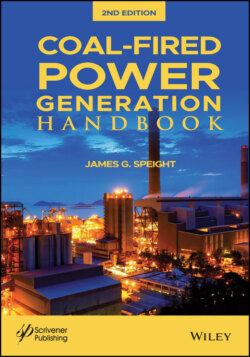Читать книгу Coal-Fired Power Generation Handbook - James Speight G., James G. Speight - Страница 91
4.2.1 Stockpile Construction
ОглавлениеThe chief danger in storing coal is spontaneous combustion and its risk can be greatly reduced if dust and fine coal are kept out of the pile. Cleaned and sifted coal with uniformly large lumps stores better than mixed sizes. Sized coal should not be stored on top of a layer of fine coal and the coal should be handled carefully to prevent breakage and dust formation – friable dusty coal should be piled in small low piles. In addition, the coal should be piled so that any part of the pile can be promptly moved if heating occurs. It is preferable to spread the coal in horizontal layers and not in conical piles to prevent the finer coal from clustering in the center and the lumps rolling to the bottom. If practical, the coal should be stored in several small stockpiles instead of one large stockpile to prevent heat buildup and make inspection of the coal easier. Coal piles should not be stockpiled higher than 12 feet and should not contain more than 1,500 tons in a single pile. No point in the interior of the stockpile should be more than 10 feet from an air-cooled surface.
In many countries many stockpiling methods have to take into account climatic conditions, dimensions, and design of the stockpiling area, as well as the type of machinery used for the stockpiling operation. The coal stockpiles formed in open areas can be generally in the form of a cone, prism, or a variety of geometric shapes. Typically, the methods of stockpiling are (i) the windrow method, (ii) the cone shell method, and (iii) the Chevron method.
The general parameters that can affect coal storage are (i) the site, especially the base upon which the coal will be stored, (ii) mitigating the tendency of spontaneous ignition of the coal, and (iii) the moisture content of the coal.
The site must be carefully chosen and prepared – the ground should be cleared of any vegetation and refuse. A hard packed clay or sandy soil is ideal but, if this is not available, a concrete pad can be installed to keep dirt out of the coal. The site should be dry, level and well drained. If the site does not drain naturally, drains should be installed around the storage pile, not underneath it as this may produce upward air currents through the pile, aiding spontaneous combustion. Make sure the site is away from any external heat sources as combustion liability increases with a rise in temperature.
The chief danger in storing coal in stockpiles is the potential for spontaneous combustion – this risk can be greatly reduced if dust and fine coal are kept out of the pile. Cleaned and sifted coal with uniformly large lumps stores better than mixed sizes – sized coal should not be placed on a layer of fine coal and the coal should be handled carefully to prevent breakage and dust formation – friable dusty coal should be piled in small low piles. The coal should be piled so that any part of the pile can be promptly moved if heating occurs. The coal should be spread in horizontal layers and not in conical piles to prevent the finer coal from clustering in the center and the lumps rolling to the bottom. If practical, the coal should be stacked in several small piles instead of one large one, to prevent heat buildup and allow the coal to be inspected. Coal can be stored covered or in the open. Wetting and drying coal repeatedly may make it more susceptible to combustion. The actions of water may break up the coal, especially after freezing and thawing. Wet coal or mixed wet coal should not be stored with dry coal and coal should not be stored on a damp base. After heavy rains and snows the coal pile should be inspected and monitored carefully.
